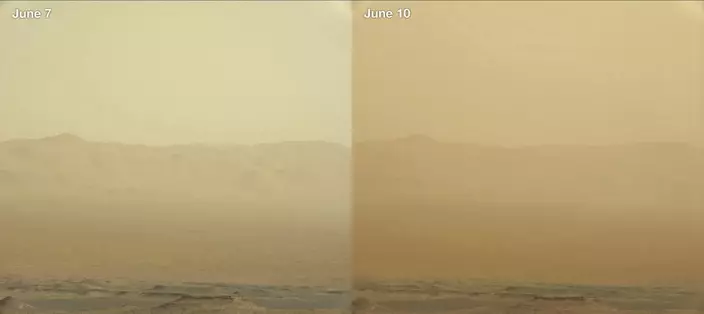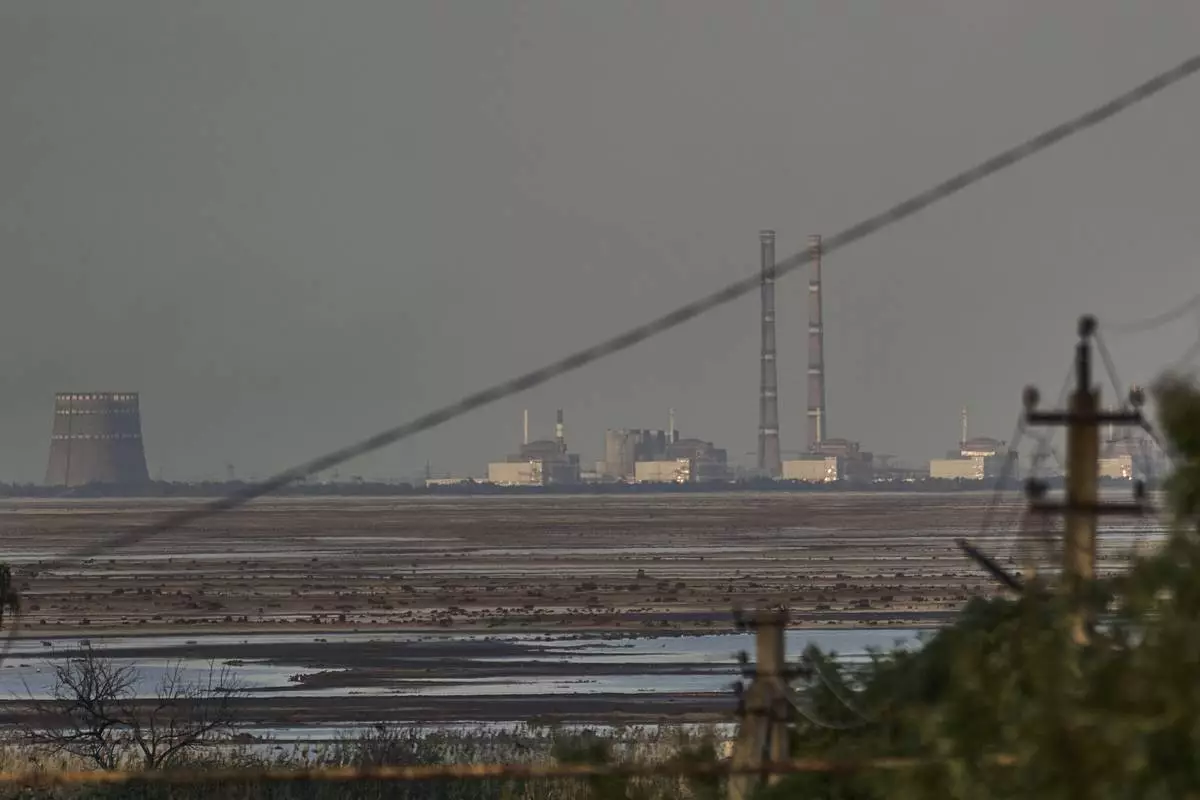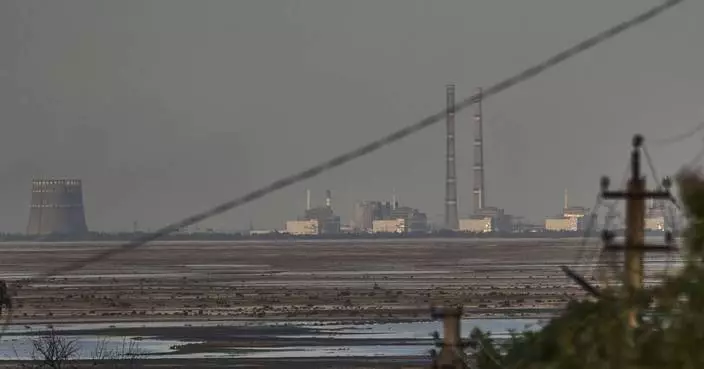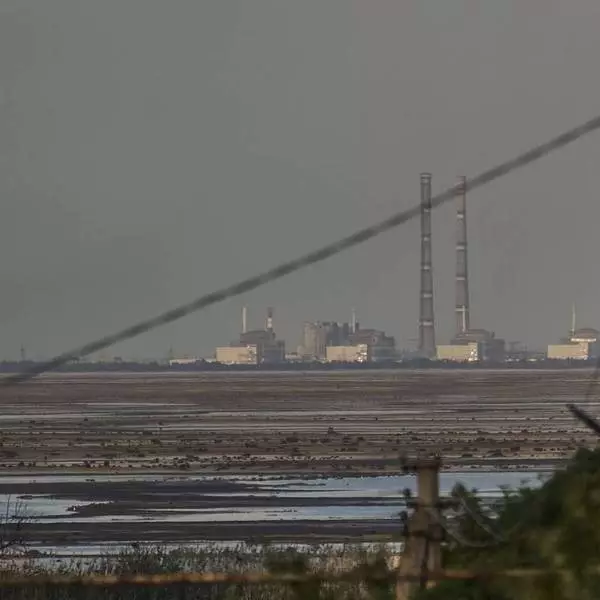NASA's seemingly unstoppable Mars rover Opportunity has been knocked out by a gigantic dust storm that is enveloping the red planet and blotting out the sun.

This composite image made from observations by NASA's Mars Reconnaissance Orbiter spacecraft shows a global map of Mars with a growing dust storm as of June 6, 2018. (NASA/JPL-Caltech/MSSS via AP)
Officials said Wednesday they're hopeful the rover will survive the storm, which already covers one-quarter of Mars and is expected to encircle the planet in another few days. It could be weeks or even months, though, until the sky clears enough for sunlight to reach the Martian surface and recharge Opportunity's batteries through its solar panels.

This combination of images made by NASA's Curiosity rover shows the rim of the Gale Crater on June 7 and 10, 2018 during a major dust storm. (NASA/JPL-Caltech/MSSS via AP)
For now, Mars' oldest working rover is stuck in the middle of the raging storm, in round-the-clock darkness.
"By no means are we out of the woods here," said John Callas, the Opportunity project manager at NASA's Jet Propulsion Laboratory in Pasadena, California. "This storm is threatening, and we don't know how long it will last, and we don't know what the environment will be like once it clears."
Flight controllers tried late Tuesday night to contact Opportunity, but the rover did not respond. The storm has been growing since the end of May with unprecedented speed.
NASA launched the twin rovers Opportunity and Spirit in 2003 to study Martian rocks and soil. They landed in 2004. Spirit hasn't worked for several years. Opportunity, however, has kept exploring well past its expected mission lifetime.
Scientists aren't nearly as concerned about the newer, nuclear-powered Curiosity rover on the other side of Mars, which is already seeing darkening skies.
Dust storms crop up every so often at Mars, sending dust tens of miles (kilometers) into the atmosphere and turning day into night. Spacecraft orbiting Mars are too high to be affected.
There's no chance of Opportunity being buried or getting a wheel stuck in dust. Even in the worst of storms, only a layer of fine dust is left behind. Managers said the main concern is that dust could temporarily cover its optical instruments.
The rover's batteries are likely so low that only a clock is still working, to wake the spacecraft for periodic power-level checks, according to officials. If the clock also goes offline, then the rover won't know what time it is when it comes back on and could send back signals at any time.
This isn't Opportunity's first major brush with dust.
In 2007, a massive dust storm kept Opportunity silent for a few days. It jumped back into action after awakening from its deep self-protecting slumber.
This time, the rover's energy level is believed to be much lower. On the plus side, Martian summertime is approaching and that should keep temperatures up at night and prevent the batteries and other parts from freezing. Besides electrical heaters, Opportunity is equipped with eight tiny plutonium-powered heaters.
Scientists are eager to learn as much as they can about the dust storm to hone their weather forecasting skills. Astronauts living on Mars, for instance, wouldn't want to get caught outside in a fierce dust storm, where winds can reach 70 mph (113 kilometers per hour) — almost hurricane force. The Martian atmosphere is so thin that while the wind can lift dust off the surface, it doesn't topple a spacecraft.
Opportunity was in remarkably good health going into the storm, Callas said, with only an arthritic joint in its robotic arm.
"Keep in mind, we're talking about a rover that's been working at Mars, hanging in there, for 15 years and designed just for 90 days," said Jim Watzin, director of NASA's Mars exploration program. "It just doesn't get any better than that."
UNITED NATIONS (AP) — Russia and Ukraine on Monday traded blame before the United Nations Security Council for the attacks on Europe’s largest nuclear power plant, which the head of the International Atomic Energy Agency said have put the world “dangerously close to a nuclear accident.”
Without attributing blame, IAEA Director General Rafael Mariano Grossi said his agency has been able to confirm three attacks against the Zaporizhzhia Nuclear Power Plant since April 7.
“These reckless attacks must cease immediately,” he told the Security Council. “Though, fortunately, they have not led to a radiological incident this time, they significantly increase the risk … where nuclear safety is already compromised.”
The remote-controlled nature of the drones that have attacked the plant means that it is impossible to definitively determine who launched them, Grossi told reporters after the meeting.
“In order to say something like that, we must have proof,” he said. “These attacks have been performed with a multitude of drones.”
Zaporizhzhia sits in Russian-controlled territory in southeastern Ukraine and has six nuclear reactors.
Fears of a nuclear catastrophe have been at the forefront since Russian troops occupied the plant shortly after invading in February 2022. Continued fighting between Russian and Ukrainian forces — as well as the tense supply situation at the plant — have raised the specter of a disaster.
Ukraine and its allies on Monday again blamed Russia for dangers at the site, with the United States saying, “Russia does not care about these risks.”
“If it did, it would not continue to forcibly control the plant,” U.S. deputy ambassador Robert Wood told the Security Council, which met at the initiative of the U.S. and Slovenia.
Russia, for its part, said Ukraine was to blame for the attacks.
“The IAEA’s report does not pinpoint which side is behind the attacks,” Russia’s U.N. Ambassador Vassily Nebenzia said. “We know full well who it is.”
“Over the last few months, such attacks not only resumed,” Nebenzia said, “they significantly intensified.”
Ukraine’s ambassador to the U.N., Sergiy Kyslytsya, called the attacks “a well-planned false flag operation by the Russian Federation,” which he alleged Russia had designed to distract the world from its invasion of its neighbor.
The Zaporizhzhia facility is one of the 10 biggest nuclear plants in the world. Fighting in the southern part of Ukraine where it is located has raised the specter of a potential nuclear disaster like the one at Chernobyl in 1986, where a reactor exploded and blew deadly radiation across a vast area.
Neither Russia nor Ukraine in recent months has been able to make significant advances along the 1,000-kilometer (620-mile) front line crossing eastern and southern Ukraine. Drones, artillery and missiles have featured heavily in what has become a war of attrition.
Russia and Ukraine have frequently traded accusations over the Zaporizhzhia plant.
The most recent strikes did not compromise the facility, which is designed to withstand a commercial airliner crashing into it, the IAEA said.
The plant’s six reactors have been shut down for months, but it still needs power and qualified staff to operate crucial cooling systems and other safety features.

FILE - The Zaporizhzhia nuclear power plant, Europe's largest, is seen in the background of the shallow Kakhovka Reservoir after the dam collapse, in Energodar, Russian-occupied Ukraine, Tuesday, June 27, 2023. Officials at the Russian-controlled Zaporizhzhia Nuclear Power Plant said that the site was attacked Sunday April 7, 2024, by Ukrainian military drones, including a strike on the dome of the plant’s sixth power unit. (AP Photo/Libkos, File)

IAEA warns that attacks on a nuclear plant in Russian-controlled Ukraine put the world at risk

IAEA warns that attacks on a nuclear plant in Russian-controlled Ukraine put the world at risk








